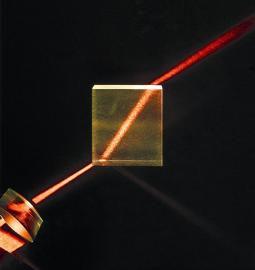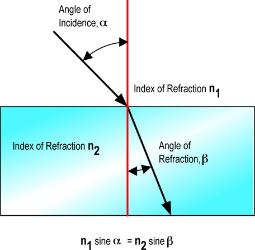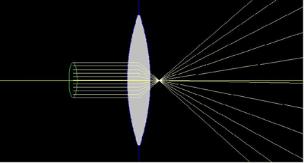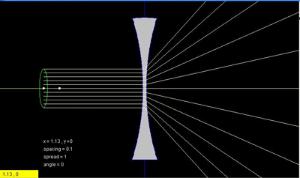|
Definition
Importance to
Scanning
|
|
- Refraction is the bending of light as it travels from one medium to another with a different
refractive index. (Fig 1)
- Refraction is what makes photography and the photographic lens possible, but is also a
disadvantage when it occurs as an unwanted add-on to the scanning process. The images of
light striking the convex and concave lens are examples of refraction with a purpose.
|
|
Effects of Unwanted
Refraction
|
|
- As an unwanted add on in scanning Refraction causes the image light rays to de-collimate or
so to speak, to spray out slightly losing sharpness.
- Film scanners and Film-Flatbed Dual scanners have an inherent technical advantage
over the ordinary flatbed scanner. This disadvantage of the flatbed scanner compared to the
Dual counterpart is compensated by the fact that the optics of the flatbed are not subject to
dust. The drawer of Dual scanners exposes the optics to dust every time it is open to insert film.
|
|
|
- Refraction degrades the image since not all light rays are perpendicular to the glass, and
instead of pinpoint landing on the sensor as a perpendicular light ray would, it is scattered
over several sensors.
- This corruption of the original image impairs resolution, contrast and saturation. .
|
|
REFRACTION AND THE
FLATBED SCANNER
|
|
- With flatbed scanners the image travels through the glass bed and is refracted by it, on the
way to the sensors; such refraction is unavoidable.
- However, additional refraction caused by the glass used to make fluid mounts need not involve
additional refraction. If the glass in the fluid mount faces the light rather than the sensors,
additional refraction is avoided.
- Epson V 750 scanners are provided with a wet mount tray which require that the film be placed
on top of the glass when wet mounted and incur double refraction because the glass is in the
path to the sensors. The In additional chunk of glass of the Epson tray effectively subtracts
some of the benefits gained by fluid scanning.
- ScanScience's simple answer to the problem is to provide an adapter that avoids glass
between the film and the sensors. The fluid mounting plate faces the lamp, with the film being
placed under the glass. The image going to the sensors is untainted by additional refraction
from the fluid mounting plate.
- In Flatbed scanners like the Epson V750, the convenience of use plus the high resolution for
Medium and Large format film is why many artists use it in place of drum scanners.
|
|
THE FILM SCANNER
Avoids Refraction
|
|
- Film Scanners have the inherent advantage over flatbeds that they are not refraction limited.
- The absence of the extra glass, potentially gives film scanners an edge.
- This advantage is retained with fluid scanning because the placement of the glass on the side
of the light NOT of the sensors.
- The inherent advantage of the Film Scanner does not help it overcome one of its
shortcomings: film curling, film unflat-ness and loss of focus.
|
|
Resolution and
Sharpness
in Flatbed Scanners
|
|
Flatbed scanner resolution is specified as fixed horizontal and variable vertical.
The ability of a scanner's optical system to resolve in both directions is fixed of course. The
optical system consists of a light source, lens and sensor unit or CCD . So why is the vertical
resolution greater than the horizontal for most flatbed scanners ?
Manufacturers take liberties with resolution figures, so instead of real resolution, the figures
really mean how many pixels /unit area the unit is set to deliver. In other wors a pixel taken is a
pixel resolved, would be the creed. Not so. The ' stepping motor ' is part of the pixel tking but it
is blind, and cannot resolve it. It can stop for a pixel being taken as it moves the sensor in a
vertical direction. A shot can be taken at various vertical distance intervals, thus, the more
frequently it stops to take a reading, the more pixels will be produced. This greater number of
pixels can result in much larger files, but the scans thus produced may not be sharper, albeit it
may be argued there are technical reasons why they should be smoother.
Users frequently compare scanner's resolution based on the figures specified by the scanner
manufacturer, and that offers manufacturer the incentive to hype the figures.
Based on the manufacturer's resolution figures a user may misguidedly rate the resolution of a
flatbed scanner as greater than that of a film scanner. However, the 4000 dpi given for a film
scanner are of real 4000 resolved pixels, while those given for the flatbed scanner are for
pixels only, resolved or otherwise.
The reality is that if a flatbed scanner can achieve a resolution of 3200 dpi or even 2400 dpi
on a MF or LF film this is excellent.
|
|







